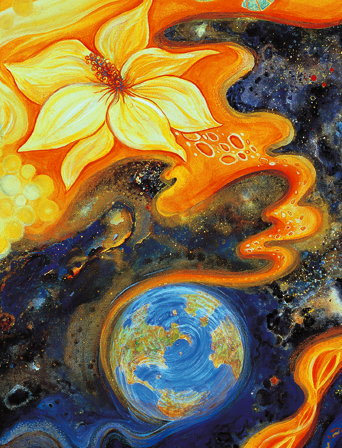
The First
Annual Story Field Conference
Imagineering
by
Tom Atlee
 |
The First
Annual Story Field Conference Imagineering by
Tom Atlee |
(Note: This article was compiled from bits and pieces written between 1997-2007 and majorly overhauled in March 2007.)
Imagineering embraces any use of imaginative narrative to realize, create, or catalyze in real life the potentials we are imagining. It often involves complete stories, in any form. But it can also involve one or more story elements -- metaphors, images, themes, perspectives, conflicts, problems, questions, goals, knowledge, possibilities, and imagined characters, situations, plots, events, resolutions, dialogue, etc. Imagineers use these story elements consciously to inspire and guide people to reshape their consciousness, their lives, and their social and physical circumstances.
(Note: I had thought I'd coined the term back in 1988 when I first used it, but I've since learned that Disney uses the word differently to refer to the creation of realistic theme parks. I want to make the distinction clear: I'm talking about using imagination to create and reshape the theme park we call real life.)
Although imagineering comes in many forms, I have my favorite. Most often when I speak of imagineering, I am referring to the use of fiction -- including a kind of visionary "journalism" ("reporting back from the future") -- to empower people to actually live out -- or into -- a particular story, vision, or possibility.
Here are a few of my favorite examples:
Some imagineering pieces do not notably impact reality -- perhaps they emerge before their time or are suppressed or systematically panned -- but they are clearly designed to inspire people live into them.
Imagineering can start with a real-life activity specifically crafted to inspire imitation. Lately such intentional efforts to generate mimicry have been successfully using the web and video -- specifically YouTube -- to spread their memes.
In broader imagineering visions, a number of eco-futurists have painted vivid pictures of societal scenarios we could live into, making once unimaginably better worlds seem siddenly possible. Here are just a few:
Imagineering can also be used to provide a narrative infrastructure to support network-based organizing. In 1988 I did a participatory imagineering experiment at a Green Gathering: With a few friends, I created a small journal called The Ecotopian Grapevine Gazette (EGG), which contained news articles about neat things that hadn't happened yet -- but which we wanted to have happen -- written AS IF they had happened. At the end of each article, we put a contact name people could contact if they wanted to join together to make that story a reality.
Amazing to me in 1988, there was little response to the EGG at the Green Gathering, and the idea hasn't taken off with anyone I've mentioned it to in the intervening years. However, I have a feeling that the time is ripening for this approach -- imagining a desired future event, phenomenon, book, activity, organization, community, etc., and then writing about it as if it has already happened, and providing contact information for those who want to make it happen -- perhaps in the form of a participatory online journal (or even classifieds kind of service like CraigsList), possibly linked into virtual practice spaces like Second Life, personal networking sites like Zaadz, meetup gatherings, videos like Climate: A Crisis Averted, funding networks like PledgePage.org, and make-a-difference online communities like Omidyar.Net, as well as the general blogging world, etc. It would be fabulous if the vast networking database called WISEREarth would include an imagineering function where people could imagine organizations they'd like to see, and be helped to find each other to make it happen.
SUMMARY
Imagineering has three elements -- story, vision, and guidance. A
story tends to be more powerful than data and ideas partly because
we can place ourselves in it vicariously and sense our own reactions and roles,
real and potential. It is almost like we are practicing for a different future.
Vision adds to the power because it points us in a
direction and paints a picture of possibility. We can only create what we can
imagine. This pulls us into the creative tension between "what is"
and "what could be", inspiring us to action. Imagineering
combines story and vision, infusing them with guidance
that gives people what they need to make the story a reality --
motivations and rationales, role models, compelling drama, realistic situations,
appropriate values struggles, all the necessary instructions and precautions
-- and sometimes even resources and compatriots -- to help their beloved product
of imagination blossom in the world around them.
Return to Story Field Conference Home Page
Illustration credit: Dana Lynne Andersen, in From
Lava to Life: the Universe Tells our Earth Story by Jennifer Morgan -- Courtesy
of Dawn Publications